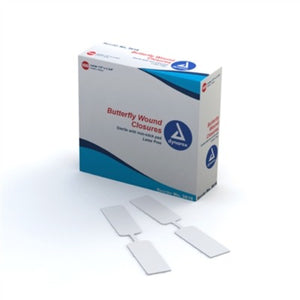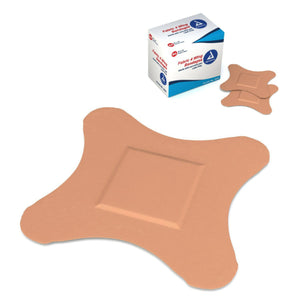Got a blister that’s taking too long to heal? Start using moleskin for blisters to get relief in no time.
Moleskin for blisters has recently become a standard treatment. It's a soft and tough fabric with sticky backing. When you put it on right, it stops rubbing and helps prevent or heal blisters. If you've already got a blister, moleskin can still rescue you.
Let’s learn all the ways and step-by-step guides to apply moleskin to a blister and feel better.
What is Moleskin?
Moleskin is a versatile material often used for preventing or treating blisters. It's a soft, durable fabric with adhesive on one side, making it easy to apply directly to the skin.
Moleskin's texture is a barrier to keeping the skin and shoe apart. It lessens friction and prevents blisters from forming.
Moreover, you can apply it over existing blisters to provide cushioning and protection and promote faster healing. Its flexibility and ease of use make moleskin a popular choice for athletes, hikers, and anyone prone to blisters.
How to Use Moleskin For Blisters? 7 Steps to Follow
Did you know that blisters are common when you're out in nature, especially for hikers? Even a tiny rub in your shoes can quickly become a big, painful blister.
But don't worry! You can keep your adventure on track with a few easy steps to treat blisters. Covering a blister with moleskin or a bandage is generally best to protect it from further irritation.
All you need is moleskin, and then you have to follow these steps:
Step-1: Gather Your Materials
Collect everything you need - moleskin, scissors, and antiseptic wipes. Make sure your hands are clean too.
Step-2: Clean and Dry the Area
Gently wipe the surrounding skin and the blister with an antiseptic wipe. It aids in clearing away any debris or germs that can lead to an infection.
Before using moleskin, make sure your skin is fully dry. You can gently pat it with a fresh towel or give it a little air drying time.
Step-3: Measure and Cut the Moleskin
Take the roll of moleskin and measure out enough to cover the blister comfortably. Use scissors to cut the moleskin to the correct size and shape carefully. Cut it slightly larger than the blister for complete coverage.
Step-4: Round the Corners
Trim the corners of the moleskin to make them rounded. It helps prevent the edges from catching on clothing or socks, which could cause the moleskin to peel off.
Carefully remove the backing from the moleskin to expose the adhesive side.
Step-5: Apply the Moleskin
Ensure the moleskin covers the blister completely. You can put the moleskin directly on the blister.
Firmly press the edges to guarantee firm adherence. To ensure the moleskin rests flat against the skin, smooth down any creases or air bubbles.
Step-6: Check for Comfort
Make sure the moleskin feels comfortable and secure. It must not be excessively tight or loose. You can trim any excess moleskin extending beyond the blister's edges if needed.
Watch the blister for the next few days. Speak with your doctor if the blister fails to heal better or gets worse or if you see any symptoms of infection, such as increasing redness, swelling, or pus.
Step-7: Change the Moleskin as Needed
If the moleskin gets damp or starts to peel off, you may need to replace it with a fresh piece. Before using the fresh moleskin, ensure the area is thoroughly cleaned.
5 Alternatives to Moleskin for Blisters
If you are allergic to moleskin or can’t find it in a short time, these alternatives to moleskin can work well:
- Blister Bandages: They have a cushioned pad that protects the blister and adhesive edges to keep it in place.
- Adhesive Padding: Foam padding with adhesive backing can provide cushioning and protection like moleskin. It is adaptable and can be trimmed to match the blistered area.
- Silicone Gel Pads: These pads provide cushioning and protection for blisters. They can be cleaned, dried, and reused several times.
- Tincture of Benzoin: This antiseptic solution can be applied to the skin to toughen it up and reduce friction to prevent blister formation.
- Toe Socks or Double Socks: Wearing toe socks or layering socks can reduce friction between the toes and other areas prone to blisters.
Where to Buy Moleskin for Blisters?
You can purchase moleskin for blisters at various places, including pharmacies, outdoor and sporting goods stores, online retailers like Amazon and Walmart, medical supply stores, and even larger grocery stores with health and beauty sections.
MoovKart has a great variety of durable moleskin blister tape, which you can order online.
You can find the ideal moleskin product if you want to purchase it in person or online. Just check product descriptions and reviews to ensure you get the best moleskin for blisters.
People Also Ask!
How Do You Use Moleskin for Bunions?
Cut moleskin for bunions into a doughnut shape, with the bunion in the center, to relieve pressure.
How Do I Heal Blisters Quickly?
To heal blisters quickly, keep them clean and protected with moleskin or bandages, and avoid popping them.
Should I Keep My Blister Moist or Dry it?
Keeping a blister moist with an antibiotic ointment promotes healing and prevents infection.





